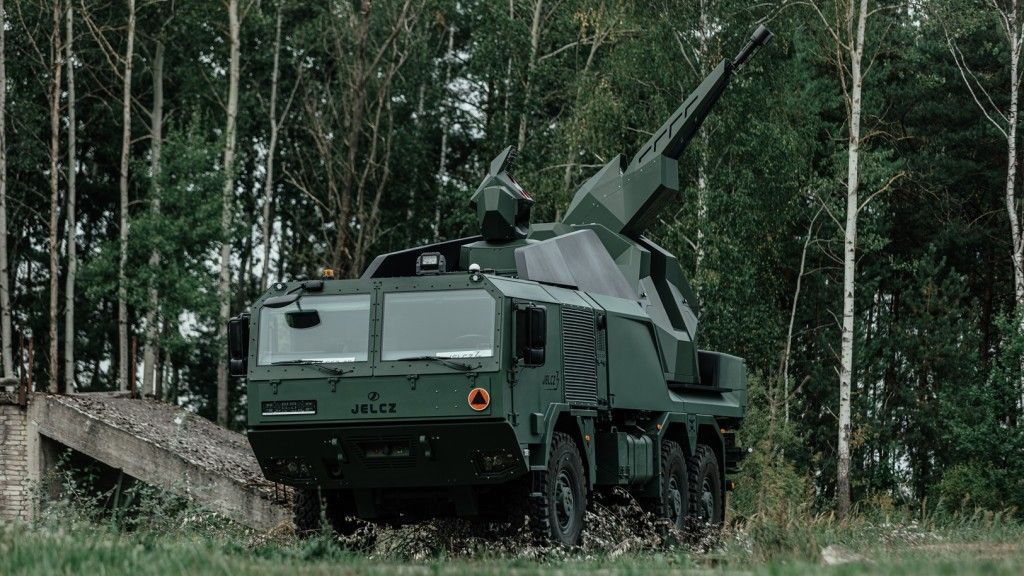Industry
35 mm Revolution in Poland's Air Defence System

During the first International Armament Congress, PIT-RADWAR presented an artillery system based on a 35 mm cannon with programmable ammunition and proposed its integration into the air defence system being developed for the Polish Armed Forces. This will involve, among other things, the introduction of anti-aircraft artillery systems mounted on AS-35 wheeled chassis.
The concept of implementing the 35 mm cannon with programmable (ABM) ammunition into the Polish air defence system was introduced by PIT-RADWAR, a company under the Polish Armaments Group (PGZ), during the first International Armament Congress. This congress takes place on 21st - 25th October in Krakow. It has been organized by the Military Institute of Armament Technology (WITU), in collaboration with the Armament Technology Institute of the Military University of Technology (WAT), under the honorary patronage of Deputy Prime Minister and Minister of National Defense Władysław Kosiniak-Kamysz, and the city of Krakow, with media support provided by Defence24.pl.
The presentation sparked significant interest, especially given the discussions that had taken place during the MSPO 2024 trade fair regarding the differences between anti-aircraft artillery systems based on 23 mm caliber and those using 35 mm caliber.
As in Kielce, the focus in Krakow was on the possibility of using programmable ABM (Air Burst Munitions) ammunition in the latter, where the shell’s detonation time is inductively programmed after precisely measuring its velocity. This solution is co-financed by the National Centre for Research and Development (NCBiR), and the work, carried out by PIT-RADWAR, the Military University of Technology, and the Mesko company, is expected to be completed by 20th June, 2025.

As demonstrated during the Congress, ABM ammunition significantly reduces ammunition consumption, especially when targeting small objects such as drones. In Krakow, results from range tests were presented regarding an unmanned aerial vehicle located 1,000 meters away, with angular dimensions of 0.5x2.0 milliradians. The tests showed that the dispersion of the AG-35 cannon was no greater than 0.5 milliradians, comparable to the size of the targeted drone.
It was also shown that to maintain a very high hit probability of 99% with at least one shell, 24 rounds of standard TP-T/FAPDS-T ammunition would be needed. However, by using programmable ABM ammunition, only seven rounds were required to achieve a hit probability of 97%, with at least 50 submunitions involved.
At the first International Armament Congress, it was proposed to use these results in a self-propelled artillery system, with an example organization of two types of air defense units based on this solution. In both cases, the base was the OSU-35K naval gun, adapted for land use, which had been previously tested on the corvette ORP “Kaszub” and is now installed on the Polish minehunter ORP “Mewa” and being mounted on subsequent Kormoran-class ships.

In both batteries proposed in Krakow, the common effector would be the self-propelled SA-35 cannon on a wheeled chassis. This artillery system can operate fully autonomously, thanks to its own fire control system based on an optoelectronic sensor (adapted from the OSU-35K naval gun) and a completely new solution – the Polish TUGA 4D radar (which measures three positional coordinates and radial velocity) with an active AESA antenna in the X-band.
This radar operates with a Frequency Modulated Continuous Wave (FMCW), which involves a relatively low signal transmission power, making it harder for enemy reconnaissance equipment to detect, thus increasing its operational safety. Despite its low power, as well as relatively small weight and dimensions, TUGA has a detection range of 50 meters to 50 kilometers (with small drones detected up to 5 kilometers away).

Based on the AS-35 artillery system, PIT-RADWAR proposed two types of very short-range air defense (VSHORAD) batteries. The first, “artillery” variant would consist of four self-propelled cannons, a WG-35 fire control vehicle, a command vehicle, and a preliminary detection radar (Soła or Bystra).

The second solution could be a combined SAM-AAA battery, which would additionally include self-propelled Poprad missile systems enhanced with, among other things, counter-UAS systems and a K-band tracking radar.
